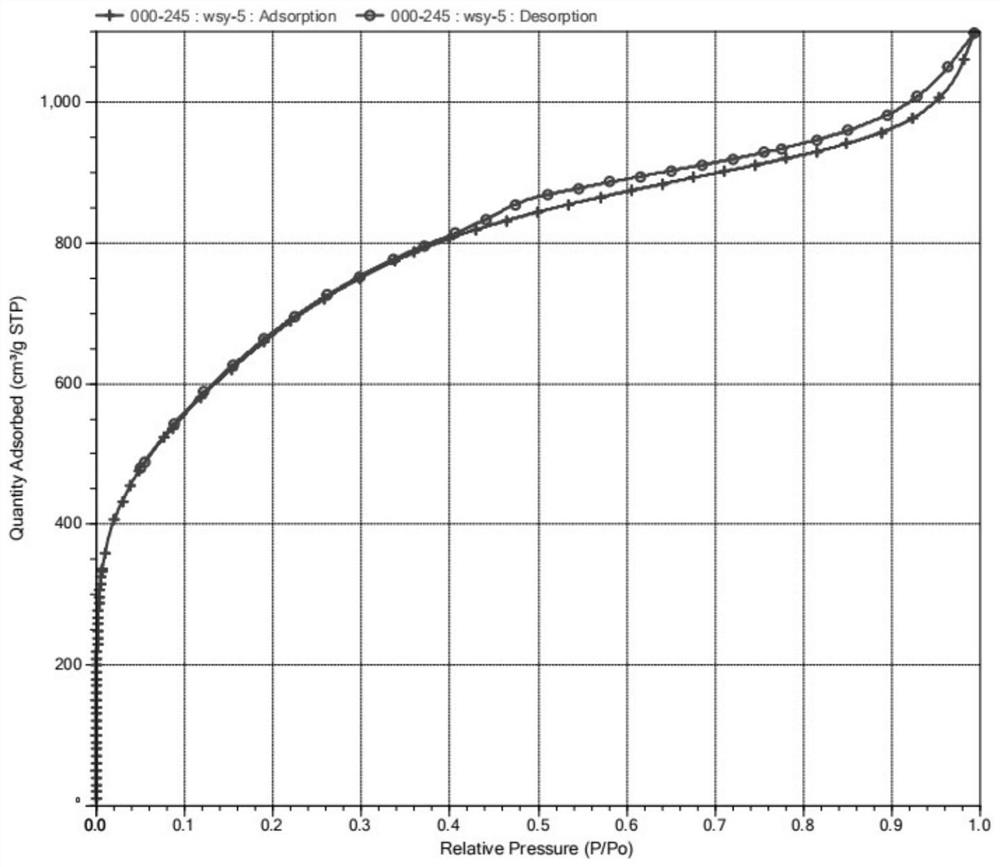Method for preparing hierarchical-pore phosphorus-doped carbon material from biomass
A biomass, multi-level pore technology, applied in chemical instruments and methods, carbon compounds, sustainable manufacturing/processing, etc., can solve the problems of inability to achieve simultaneous deashing, acid loading and pre-carbonization, uniform incorporation of phosphorus atoms, The problems of small specific surface area of carbon materials, etc., to achieve the effect of simple and easy production process, low price and high doping amount
- Summary
- Abstract
- Description
- Claims
- Application Information
AI Technical Summary
Problems solved by technology
Method used
Image
Examples
Embodiment 1
[0059] In this example, six different types of biomass raw materials were selected and pulverized into 40-80 mesh particles, and 4g of the above biomass particles were weighed for use, and hierarchically porous phosphorus-doped carbons were prepared according to the following preparation methods Material;
[0060] A method for preparing a hierarchically porous phosphorus-doped carbon material from biomass, comprising the following steps:
[0061] Step 1, crushing the biomass into 40-80 mesh particles;
[0062] Step 2, weighing 4 g of the pulverized biomass particles and mixing them evenly with phosphoric acid solution at a ratio of phosphorus to carbon mass ratio of 3:1 to form a mixture;
[0063] Step 3. Put the mixture into a 50ml hydrothermal reaction kettle, and perform a hydrothermal reaction at a hydrothermal temperature of 200°C for 12 hours to generate hydrothermal carbon;
[0064] Step 4, open the reaction kettle after complete cooling, pour the hydrothermal carbon ...
Embodiment 2
[0070] In this example, the influence of different phosphorus sources and acid sources on the properties of the hierarchically porous phosphorus-doped carbon material was tested, only the types of phosphorus sources and acid sources were changed, and the materials were prepared according to the following preparation method;
[0071] A method for preparing a hierarchically porous phosphorus-doped carbon material from biomass, comprising the following steps:
[0072] Step 1, pulverizing the sawdust biomass into 40-80 mesh particles;
[0073] Step 2, weighing 4 g of the pulverized biomass particles and mixing them evenly with the phosphoric acid-containing solution at a phosphorus-to-carbon mass ratio of 3:1 to form a mixture;
[0074] Step 3. Put the mixture into a 50ml hydrothermal reaction kettle, and perform a hydrothermal reaction at a hydrothermal temperature of 200°C for 12 hours to generate hydrothermal carbon;
[0075] Step 4, open the reaction kettle after complete coo...
Embodiment 3
[0081] In this example, the influence of different hydrothermal temperatures on the properties of the hierarchically porous phosphorus-doped carbon material was tested, only the hydrothermal temperature was changed, and the material was prepared according to the following preparation method;
[0082] A method for preparing a hierarchically porous phosphorus-doped carbon material from biomass, comprising the following steps:
[0083] Step 1, pulverizing the sawdust biomass into 40-80 mesh particles;
[0084] Step 2, weighing 4 g of the pulverized biomass particles and mixing them evenly with phosphoric acid solution at a ratio of phosphorus to carbon mass ratio of 3:1 to form a mixture;
[0085] Step 3. Put the mixture into a 50ml hydrothermal reaction kettle, and perform a hydrothermal reaction at a hydrothermal temperature of 70°C, 150°C, 200°C, and 300°C for 12 hours to generate hydrothermal carbon;
[0086] Step 4, open the reaction kettle after complete cooling, pour the ...
PUM
| Property | Measurement | Unit |
|---|---|---|
| specific surface area | aaaaa | aaaaa |
| specific surface area | aaaaa | aaaaa |
Abstract
Description
Claims
Application Information
 Login to View More
Login to View More - R&D
- Intellectual Property
- Life Sciences
- Materials
- Tech Scout
- Unparalleled Data Quality
- Higher Quality Content
- 60% Fewer Hallucinations
Browse by: Latest US Patents, China's latest patents, Technical Efficacy Thesaurus, Application Domain, Technology Topic, Popular Technical Reports.
© 2025 PatSnap. All rights reserved.Legal|Privacy policy|Modern Slavery Act Transparency Statement|Sitemap|About US| Contact US: help@patsnap.com



